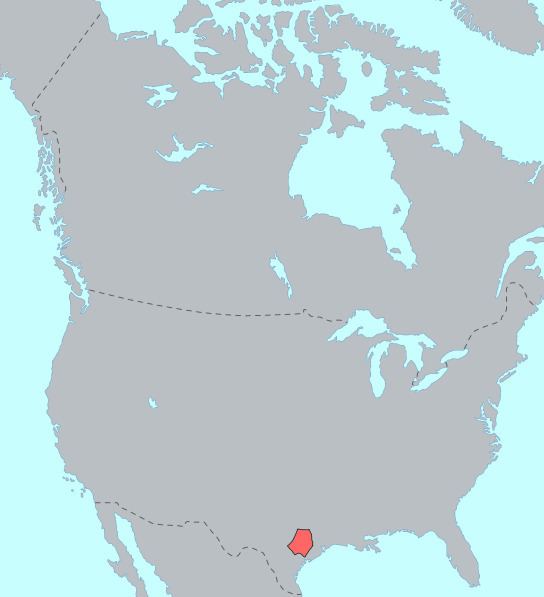Glottolog tonk1249 | Extinct ca. 1940 ISO 639-3 tqw | |
 | ||
Region | ||
The Tonkawa language was spoken in Oklahoma, Texas, and New Mexico by the Tonkawa people. A language isolate, with no known related languages, Tonkawa is now extinct. Members of the Tonkawa tribe now speak English.
Contents
Vowels
Tonkawa has 10 vowels:
Consonants
Tonkawa has 15 consonants:
Consonant clusters
There are two environments in which consonant clusters occur in Tonkawa:
Repeated or identical consonants are treated as one unit. However, the condition that causes this repetition has not been fully analyzed.
There are cases where the glottal stop is not used in the cluster or combination
There are certain consonants that can either begin or end in a cluster. However, if the cluster begins the syllable, there can be no intervening vowel.
Phonological processes and morphophonemics
Initial stem syllables that begin with h-
Final stem syllables
An interesting feature of Tonkawan phonology is that the vowels in even-numbered syllables are reduced. That is, long vowels are shortened, while short vowels disappear. Analyses of this were given by Kisseberth (1970), Phelps (1973, 1975) and Noske (1993).
Syllable structure
The Tonkawa language is a syllabic language that bases its word and sentence prosody on even stressed syllables.
There are five types of syllable arrangements: (CL consonant, CC: consonant cluster, V: vowel)
Morphology
Morphological terms that are important for Tonkawa:
These are distinguished by hyphens. Example: ka-la 'mouth'
The morphemes in Tonkawa can be divided as follows:
I. Themes
In Tonkawa the theme is composed of morphologic units. The basic unit is the stem. The stem is composed of two elements (the consonant and vowel) and modified by affixes. The theme, or stem, is functional, which means it changes as more affixation is added. This leads to the fusion of the stem and affix where it becomes difficult to isolate the word into its smaller units.
II. Affixes
III. Enclitics
Grammar
Unlike English, where the pronouns, nouns, verbs, etc. are individual words, Tonkawa forms these parts of speech in a different manner. In Tonkawa, the most important grammatical function is affixation. This process shows the subjects, objects, and pronouns of words and/or verbs. Within affixations, the suffix has more importance than the prefix.
The differenation between subject and object is shown in the word ending, aka the suffix. While the word order tends to be subject, object, verb (SOV), compounding words is very common in Tonkawa. Reduplication is very common in Tonkawa and affects only the verb themes. Usually only one syllable is duplicated, and this duplication symbolizes a repeated action, vigorous action, or a plural subject.
Nouns
Nouns function as free themes, or stems, in Tonkawa. There is a limit of only two or three affixes that can compound with a noun. However, there are cases were a bound theme can occur in noun compounds. This occurs with the suffix -an is added. In English, pronouns and nouns are usually grouped together, but because pronouns in Tonkawa are bound themes, they will be discussed with the verb section.
Noun suffixes
Verbs
Verbs are bound morphemes that have a limit of only two themes, of which the 2nd theme is the modifying theme. The 2nd theme usually serves an adverbial theme. However, if the suffix -ʔe/-wa is added the verb functions as a free theme.
Pronouns
Pronouns are only used for emphasis on the subject and are affixated as prefixes. Person and number are usually indicated by the affixation of the verb. Most pronouns are bound themes, especially the demonstrative pronouns.
Demonstrative pronouns
Demonstrative adverbs can be formed by adding -ca 'place', -l 'direction', -c 'manner' to the demonstrative pronouns below. Example: waː 'that one aforementioned' + ca 'place = 'waː-ca 'that place aforementioned'
Interrogative pronouns can be formed by adding the prefix he- to the demonstrative pronouns as well, using the same format for the demonstrative adverbs. Example: he 'interrogative' + teː 'this' + l 'direction' = he-teː-l 'where'
Indefinite pronouns can also be formed with affixation. (Interrogative + ʔax) Example: hecuː 'what' + ʔax = hecuː-ʔax 'anything, something, anyone, someone'
Also within the verbal-prefix category exist the causatives ya- and nec-, where ya- is the older form.
Verb suffixes
Verb suffixes are important in Tonkawa because they usually indicate the tense, negativity, and manner (outside of that which is conveyed in the aforementioned prefixes) of the action performed.
Enclitics
Enclitics are bound morphemes that are suffixed to verbs, nouns, and demonstratives that end with -k. Enclitics often express modal concepts in Tonkawa, which occur in the declarative, interrogative, and quotative/narrative clauses or statements.
Writing system
The orthography used on the Tonkawa Tribe's website is similar to Americanist phonetic notation.
Long vowels are indicated with a following middle dot ⟨·⟩. The affricate /ts/ is written ⟨c⟩. The glottal stop /ʔ/ is written as either an apostrophe ⟨'⟩ or as a superscript question mark ⟨?⟩. The palatal glide /j/ is written ⟨y⟩.
The phonemic orthography used in Hoijer's Tonkawa Texts is a later version of Americanist transcription. It uses a colon for long vowels ⟨:⟩ and the traditional glottal stop symbol ⟨ʔ⟩. Examples are mummun 'salt' and mummunchicew 'pepper'.
Example
The following text is the first four sentences of Coyote and Jackrabbit, from Hoijer's Tonkawa Texts.
ha·csokonayla ha·nanoklaknoˀo xamˀalˀa·yˀik. ˀe·kʷa tanmaslakʷa·low hecne·laklaknoˀo lak. ha·csokonayla "ˀo·c!" noklaknoˀo. "ˀekʷanesxaw sa·ken nenxales!" noklaknoˀo. ˀe·ta tanmaslakʷa·lowa·ˀa·lak hewleklaknoˀo.Gloss:
Coyote / he was going along, S / on the prairie. When he did so / Jackrabbit / he was lying, S / (accus.). Coyote / "Oho!" / he said, S. "Horse /my / I have found it!" / he said, S. And then / that Jackrabbit afm / he caught him, S.In this gloss, S is an abbreviation for "it is said", and afm for "the aforementioned".
